FREEMASONRY
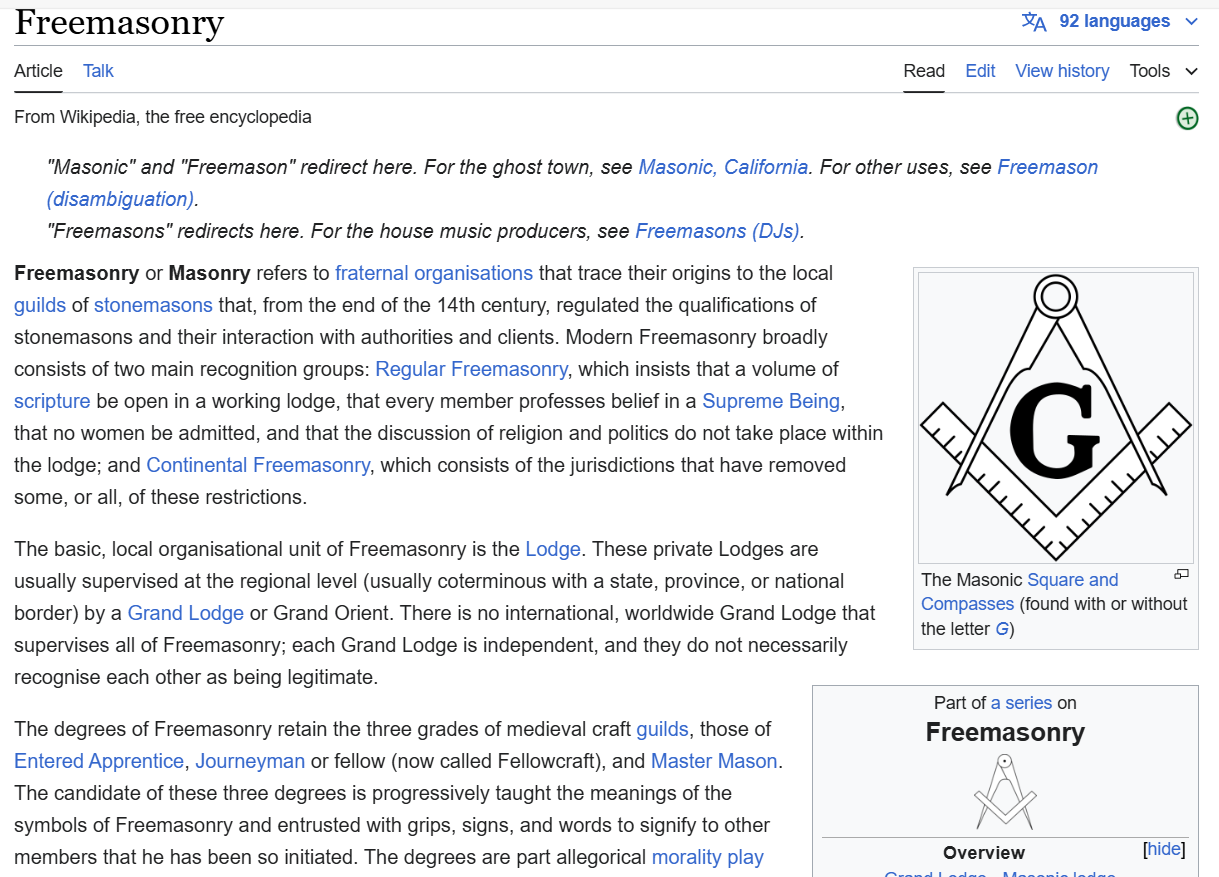
The degrees of Freemasonry retain the three grades of medieval craft guilds, those of Entered Apprentice, Journeyman or fellow (now called Fellowcraft), and Master Mason. The candidate of these three degrees is progressively taught the meanings of the symbols of Freemasonry and entrusted with grips, signs, and words to signify to other members that he has been so initiated. The degrees are part allegorical morality play and part lecture. These three degrees form Craft (or Blue Lodge) Freemasonry, and members of any of these degrees are known as Freemasons or Masons. There are additional degrees, which vary with locality and jurisdiction, and are usually administered by their own bodies (separate from those who administer the Craft degrees).[9]
Origins
Goose and Gridiron, where the Grand Lodge of London and Westminster, later called the Grand Lodge of England, was founded
Since the middle of the 19th century, Masonic historians have sought the origins of the movement in a series of similar documents known as the Old Charges, dating from the Regius Poem in about 1425[42] to the beginning of the 18th century. Alluding to the membership of a lodge of operative masons, they relate it to a mythologised history of the craft, the duties of its grades, and the manner in which oaths of fidelity are to be taken on joining.[43] The 15th century also sees the first evidence of ceremonial regalia.[44]
There is no clear mechanism by which these local trade organisations became today's Masonic Lodges. The earliest rituals and passwords known, from operative lodges around the turn of the 17th–18th centuries, show continuity with the rituals developed in the later 18th century by accepted or speculative Masons, as those members who did not practice the physical craft gradually came to be known.[45] The minutes of the Lodge of Edinburgh (Mary's Chapel) No. 1 in Scotland show a continuity from an operative lodge in 1598 to a modern speculative Lodge.[46] It is reputed to be the oldest Masonic Lodge in the world.[47]
View of room at the Masonic Hall, Bury St Edmunds, Suffolk, England, early 20th century, set up for a Holy Royal Arch convocation
Alternatively, Thomas De Quincey in his work titled Rosicrucians and Freemasonry put forward the theory that suggested that Freemasonry may have been an outgrowth of Rosicrucianism. The theory had also been postulated in 1803 by German professor; J. G. Buhle.[48][49]
The first Grand Lodge, the Grand Lodge of London and Westminster, later called the Grand Lodge of England, was founded on St John's Day, 24 June 1717,[50] when four existing London Lodges met for a joint dinner. Over the next decade, most of the existing Lodges in England joined the new regulatory body, which itself entered a period of self-publicity and expansion. New lodges were created and the fraternity began to grow.
During the course of the 18th century, as aristocrats and artists crowded out the craftsmen originally associated with the organization, Freemasonry became fashionable throughout Europe and the American colonies.[51][52]
Between 1730 and 1750, the Grand Lodge endorsed several significant changes that some Lodges could not endorse. A rival Grand Lodge was formed on 17 July 1751, which called itself the "Antient Grand Lodge of England” to signify that these lodges were maintaining older traditions, and rejected changes that “modern” Lodges had adopted (historians still use these terms - “Ancients” and “Moderns” - to differentiate the two bodies). These two Grand Lodges vied for supremacy until the Moderns promised to return to the ancient ritual. They united on 27 December 1813 to form the United Grand Lodge of England. [53][54]
The Grand Lodge of Ireland and the Grand Lodge of Scotland were formed in 1725 and 1736, respectively, although neither persuaded all of the existing lodges in their countries to join for many years.[55][56]
North America
Erasmus James Philipps, first Freemason in present-day Canada, Old Burying Ground (Halifax, Nova Scotia)
The earliest known American lodges were in Pennsylvania. The Collector for the port of Pennsylvania, John Moore, wrote of attending lodges there in 1715, two years before the putative formation of the first Grand Lodge in London. The Grand Lodge of England appointed a Provincial Grand Master for North America in 1731, based in Pennsylvania,[57] leading to the creation of the Grand Lodge of Pennsylvania.
In Canada, Erasmus James Philipps became a Freemason while working on a commission to resolve boundaries in New England and, in 1739, he became provincial Grand Master for Nova Scotia; Philipps founded the first Masonic lodge in Canada at Annapolis Royal, Nova Scotia.[58]
Other lodges in the colony of Pennsylvania obtained authorisations from the later Antient Grand Lodge of England, the Grand Lodge of Scotland, and the Grand Lodge of Ireland, which was particularly well represented in the travelling lodges of the British Army.[59][60] Many lodges came into existence with no warrant from any Grand Lodge, applying and paying for their authorisation only after they were confident of their own survival.[61]
After the American Revolution, independent U.S. Grand Lodges developed within each state. Some thought was briefly given to organising an overarching "Grand Lodge of the United States," with George Washington, who was a member of a Virginian lodge, as the first Grand Master, but the idea was short-lived. The various state Grand Lodges did not wish to diminish their own authority by agreeing to such a body.[5]
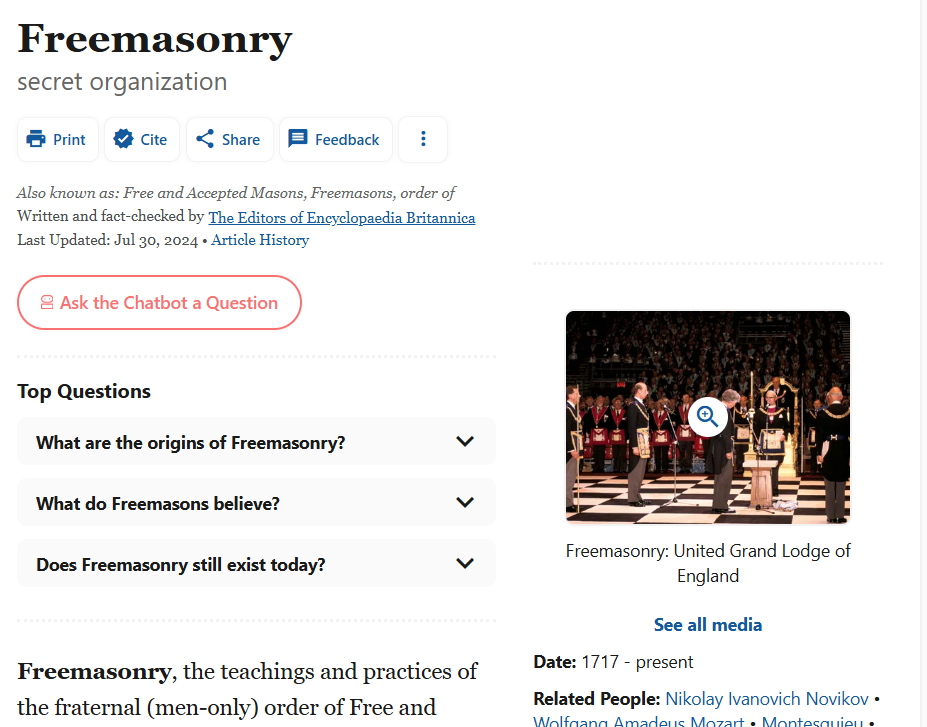
Freemasonry | Definition, History, Stages, Lodges, & Facts | Britannica
Freemasonry has, almost from its inception, encountered considerable opposition from organized religion, especially from the Roman Catholic Church, and from various states. Freemasonry is not a Christian institution, though it has often been mistaken for such. Freemasonry contains many of the elements of a religion; its teachings enjoin morality, charity, and obedience to the law of the land. In most traditions, the applicant for admission is required to be an adult male, and all applicants must also believe in the existence of a Supreme Being and in the immortality of the soul. In practice, some lodges have been charged with prejudice against Jews, Catholics, and nonwhites. Generally, Freemasonry in Latin countries has attracted those who question religious dogma or who oppose the clergy (see anticlericalism), whereas in the Anglo-Saxon countries the membership is drawn largely from among white Protestants. The modern French tradition, founded in the 19th century and known as Co-Freemasonry or Le Droit Humain, admits both women and men.
In most lodges in most countries, Freemasons are divided into three major degrees—entered apprentice, fellow of the craft, and master mason. In many lodges there are numerous degrees—sometimes as many as a thousand—superimposed on the three major divisions; these organizational features are not uniform from country to country.
In addition to the main bodies of Freemasonry derived from the British tradition, there are also a number of appendant groups that are primarily social or recreational in character, having no official standing in Freemasonry but drawing their membership from the higher degrees of the society. They are especially prevalent in the United States. Among those known for their charitable work are the Ancient Arabic Order of the Nobles of the Mystic Shrine (the “Shriners”). In Britain and certain other countries there are separate lodges restricted to women. In addition, female relatives of master masons may join the Order of the Eastern Star, which is open to both women and men; boys may join the Order of DeMolay or the Order of the Builders; and girls may join the Order of Job’s Daughters or the Order of the Rainbow. English Masons are forbidden to affiliate with any of the recreational organizations or quasi-Masonic societies, on pain of suspension.
Protocols of the Elders of Zion, also called Protocols of the Learned Elders of Zion, fraudulent document that served as a pretext and rationale for anti-Semitism mainly in the early 20th century. The document purported to be a report of a series of 24 (in other versions, 27) meetings held at Basel, Switzerland, in 1897, at the time of the first Zionist congress. There Jews and Freemasons were said to have made plans to disrupt Christian civilization and erect a world state under their joint rule. Liberalism and socialism were to be the means of subverting Christendom; if subversion failed, all the capitals of Europe were to be sabotaged.
The Protocols were printed in Russia in abbreviated form in 1903 in the newspaper Znamia (“Banner”) and subsequently (1905) as an addendum to a religious tract by Serge Nilus, a tsarist civil servant. They were translated into German, French, English, and other European languages and soon came to be a classic of anti-Semitic literature. In the United States Henry Ford’s private newspaper, Dearborn Independent, often cited them as evidence of a Jewish threat.
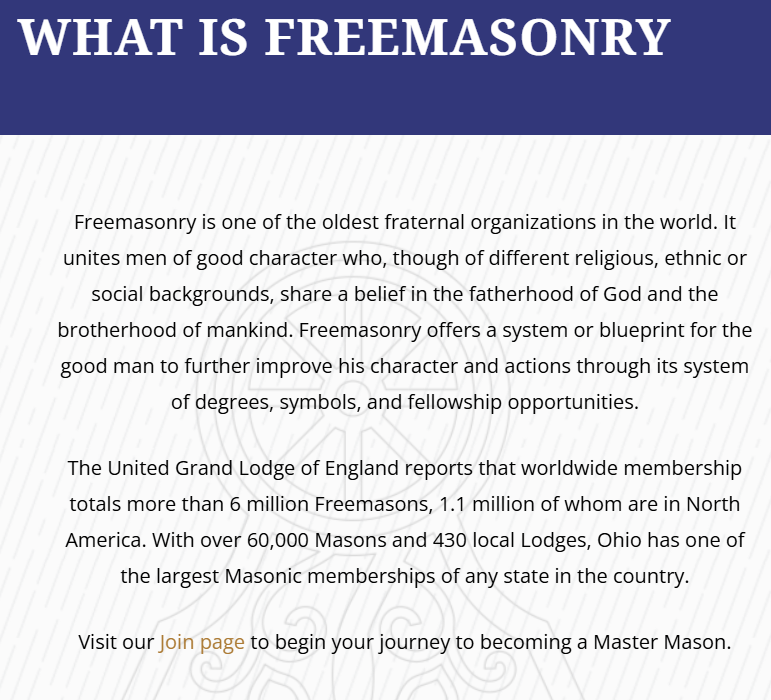
What is Freemasonry? - Freemasonry
Modern Freemasonry was established in England in 1717, although its exact origins are lost in the unrecorded history of medieval times. Its roots are found in guilds of stonemasons that, from the end of the 13th century, regulated the qualifications of stonemasons. As a stonemason grew in his craft, he was entered into the appropriate rank: apprentice, journeyman (now called Fellow Craft) and master mason.
At each stage, the craftsman was entrusted with the secrets of each level, which include passwords and grips (or handshake) made known to him only upon due inspection of necessary proficiency by a master of the craft. This way, as stonemasons migrated across Europe to the next job, each man was assured proper pay and privilege commensurate with his skill level, and clients were assured of the quality of work. Today, Freemasonry shares this same system of secrets, ritual and growth, though the work has shifted from building edifices to building oneself in good character.
Freemasonry – Secret Societies Exposed (evangelicaltruth.com)
Freemasonry is without doubt the largest and most powerful secret society existing throughout the world today. Whilst Freemasonry is considered by many as sinister and destructive, it still maintains a significant position of influence in certain parts of the world. Freemasonry has prided itself in its cherished secrets. It has been able to conceal its practices and teaching behind a façade of respectability and propriety for years. However, like never before, Freemasonry, its degrees and secrets are being exposed through numerous revealing books, TV programs and the internet exposures. Unprecedented numbers of disillusioned former Masons are exposing the secrets that they were once bound by. This has resulted in a stark decline in numbers. Insiders are becoming disillusioned and outsiders are being scared off as more and more detail is exposed for the world to see. The Masonic membership is becoming increasingly concerned about its external image, as potential members are shunning the order in significant numbers. Not liking being exposed, the normally highly-secretive Freemasons have of late been actively engaging in a public relations offensive in order to resuscitate the ailing order. It has been swinging its doors open to some of its more innocuous installation ceremonies and running to the media to highlight the slightest of charitable acts in an attempt to boost its withering image.
Christian objections
For years Freemasonry has told us that the Lodge and its internal workings completely accord with the precepts of Christianity and the teaching of the Bible. It is the purpose of this site to examine these claims and establish the real meaning and import of the teaching and practices of Freemasonry. We also want to analyze its origins. We will expose anything withinFreemasonry that we find that contradicts the Holy Scriptures.
Christians have traditionally opposed Freemasonry on several grounds. First and foremost they object to its mystical teaching and practices because of what they consider their anti-scriptural nature. Freemasonry is widely-known for adding to the sacred text, revising it and then applying it to its fictional religious heros or esoteric concepts. It is an institution that unapologetically derives it origin and inspiration from religious mysticism and pagan tradition. Lesson after lesson and precept after precept within the Lodge are seen to contradict the teaching of the Scriptures. Elaborate rituals and esoteric ceremonies are alien to what is shown in the New Testament for Christian practice. Freemasonry regularly takes various office titles and spiritual descriptions from the Bible (Old and New Testament) that pertain exclusively to God or His servants and apply them to its members.
The example of the Church in Scripture is that of an open institution that gladly shares its teaching with the whosoever, a function that seems to run totally contrary to that of Freemasonry. The whole secrecy aspect of Freemasonry runs against that laid out by Christ for the function of the Church in this New Testament era. He instructed the Church to take the Gospel message out to the whole world. It was paganism that shrouded its procedures in secrecy.
Masonic members are fully aware that Freemasonry is just a modern mutation of the ancient mysteries. The Lodge shares most of its rituals, oral tradition and symbolism with the occult world. The fact that its religious practices and teaching are strictly hidden from outside scrutiny is testimony, in the eyes of most Christians, to the bogus nature of its religious ceremonies. Freemasonry must of necessity protect its dark degrading procedures from outside scrutiny.
Christians object to Freemasonry’s treatment of Jesus Christ. He is reduced to a mere moral leader that is no different to the many leaders of all other religions. In stark contrast to Christianity, the fictional character Hiram Abiff and his pretended life, death and resurrection is central to Freemasonry theology. Christians hold that this nullifies the teaching of the Bible and undermines the preeminent position Christ holds as man’s Saviour and Lord. This fantasy figure is continually presented as a fitting model and constant example of how Freemasons should conduct themselves. A ceremonial new birth experience that Masons are said to undergo is said to be based on the mythical life, death and resurrection of Hiram Abiff! This whole imaginative sham makes a mockery of Christ and His impeccable life, His atoning death and victorious resurrection. Instead of identifying exclusively with Christ, Hiram is pushed to the fore as a preferred prototype. Christians reject this mythical invention.
We would recommend recommend a revealing book written by the great revivalist Charles Finney who was a former Freemason (The Character, Claims And Practical Workings Of Freemasonry):
Christians object to how Freemasonry presents salvation. It is sold as a gradual process of spiritual enlightenment. It is portrayed as being attained by ascending through the Masonic degree system. According to Freemasonry, salvation is found within the confines of the Lodge, not in Jesus Christ. All outside of the Lodge are considered blind and ignorant. This is taught throughout their degrees. Renowned Masonic writer Albert Mackey states, “The Master Mason represents a man saved from the grave of iniquity, and raised to the faith of salvation” (Manual of the Lodge). The Lodge present Hiram and his fabled death, burial and resurrection as a powerful illustration of man’s salvation. Christians hold to the biblical concept that salvation is found exclusively in Jesus Christ and His atoning on the cross. Acts 4:12 says: “Neither is there salvation in any other: for there is none other name under heaven given among men, whereby we must be saved.”
Bible-believing Christians therefore reject Freemasonry as pagan, anti-Christian and spurious
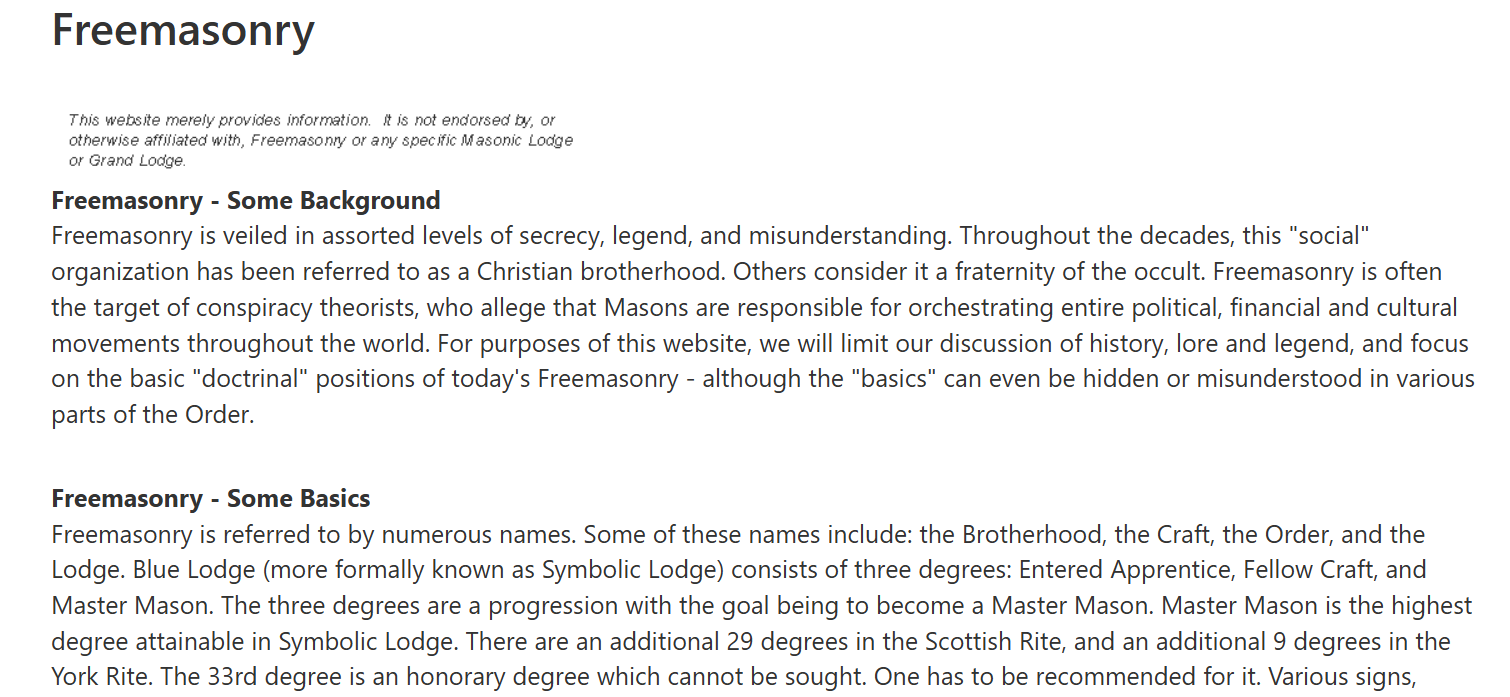
Freemasonry (allaboutcults.org)
Freemasonry - Some Background
Freemasonry is veiled in assorted levels of secrecy, legend, and misunderstanding. Throughout the decades, this "social" organization has been referred to as a Christian brotherhood. Others consider it a fraternity of the occult. Freemasonry is often the target of conspiracy theorists, who allege that Masons are responsible for orchestrating entire political, financial and cultural movements throughout the world. For purposes of this website, we will limit our discussion of history, lore and legend, and focus on the basic "doctrinal" positions of today's Freemasonry - although the "basics" can even be hidden or misunderstood in various parts of the Order.
Freemasonry - Some Basics
Freemasonry is referred to by numerous names. Some of these names include: the Brotherhood, the Craft, the Order, and the Lodge. Blue Lodge (more formally known as Symbolic Lodge) consists of three degrees: Entered Apprentice, Fellow Craft, and Master Mason. The three degrees are a progression with the goal being to become a Master Mason. Master Mason is the highest degree attainable in Symbolic Lodge. There are an additional 29 degrees in the Scottish Rite, and an additional 9 degrees in the York Rite. The 33rd degree is an honorary degree which cannot be sought. One has to be recommended for it. Various signs, tokens, and secrets are made known to the Mason as he graduates to higher levels or degrees. One of the most known symbols for Masonry is the letter "G." Depending on whose interpretation you believe, this symbol can represent geometry, God, or gnosis. Christians traditionally interpret the symbol as God, whereas others within the Order define it as knowledge or gnosis.
There is a great deal of secrecy in Freemasonry. From the beginning, the Entered Apprentice is kept in the shadows regarding the full meaning of Masonry's symbols and ceremonies. A member of the Lodge only receives further enlightenment as he rises through the degrees. Each Mason must swear a series of oaths to keep the secrets of the Craft as he learns them. He also agrees to severe penalties if he ever lets them slip. "Freemasons are emphatically called the Sons of Light, because they are in possession of the true meaning of the symbol; while the profane or uninitiated who have not received this knowledge are said to be in darkness." (Albert Mackey, Encyclopedia of Freemasonry, 1946) As the Mason passes through the degrees of the Lodge, he receives true light, and is considered elevated above those who have not had the mysteries of Freemasonry revealed to them.
reemasonry - Is It a Religion?
The Mason's official position states that Freemasonry is not a religion. "Masons who treat it as such are mistaken. Freemasonry strongly encourages its members to belong to an established religion, although this is not a requirement for membership (only that a candidate profess a belief in a Supreme Being). Masonry is a fraternal organization that encourages morality and charity and studies philosophy. It has no clergy, no sacraments, and does not promise salvation to its members" (Roger Firestone, Difficult Questions About Freemasonry, 2002).
A close assessment of the degrees of Freemasonry uncovers a basic theology that lies beneath everything in the Order. The degrees instruct that: There is a Supreme Being who created the universe, who has established and revealed a moral law, and to whom we must give account in a life after this. Masons argue that nothing in these five points, which are supported by all the materials, lectures and "working tools" of the degrees, conflicts with any of the major religions of the Western world. As such, all religions are welcome to participate in the Brotherhood, and thus, it should not be deemed a "religious" organization. "The true Mason is not creed-bound. He realizes with the divine illumination of his lodge that as a Mason his religion must be universal: Christ, Buddha, or Mohammed, the name means little, for he recognizes only the light and not the bearer"(Manly Hall, The Lost Keys of Freemasonry, 1976).
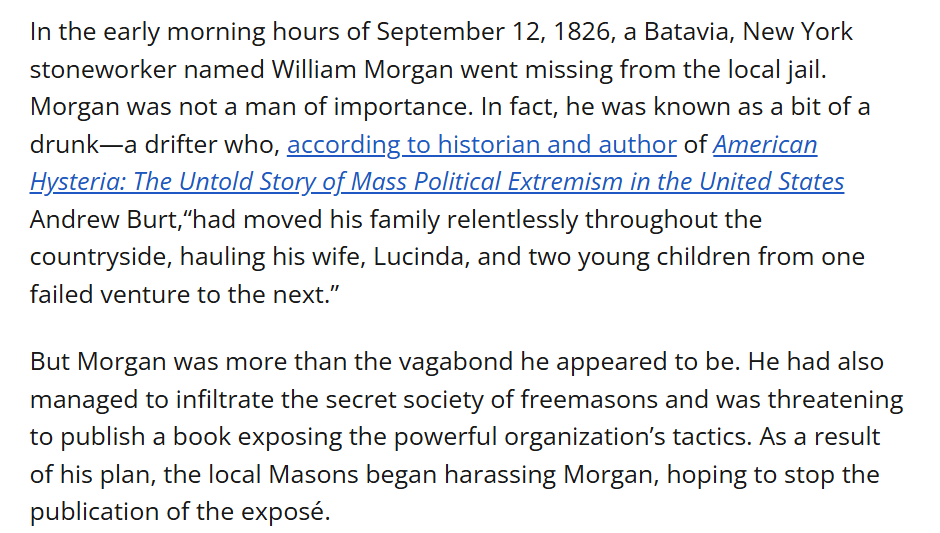
One Man Exposed the Secrets of the Freemasons. His Disappearance Led to Their Downfall - HISTORY
The first Masonic lodges began showing up in the colonies in the early 18th century, and swiftly gained power and influence. Members of the Freemasons eventually played a pivotal role in the formation of the United States—13 of the 39 signatures on the U.S. Constitution belonged to Masons—and, by the time Morgan disappeared in the 1820s, it had representatives entrenched at every level of the country’s social, economic and political hierarchies. Nowhere was this more true than in New York.
The Steps of Freemasonry.
To Morgan, and his friend David C. Miller, a local newspaper publisher struggling to keep his publication afloat, the successful Freemasons presented a daily reminder of wealth that seemed, for them, simply unattainable. As A.P. Bentley wrote in his 1874 book History of the Abduction of William Morgan and the Anti-Masonic Excitement of 1826-30, The two men “entered into partnership to print a book which the public was to be told disclosed the secrets of masonry, in hopes to make a fortune out of the gaping curiosity of the vulgar.”
Under the false pretenses of being a Mason himself, Morgan gained access to the local lodge and documented several of the organization’s cryptic ceremonies and induction rituals. Once Morgan had these veiled details down on paper, Miller began teasing their very public release. In August of 1826, Miller hinted at the incendiary nature of the upcoming exposé, saying he had discovered the “strongest evidence of rottenness” in the centuries-old institution.
Miller and Morgan’s threat to reveal the innermost secrets of the Masons spread quickly. In every neighboring county, Masonic chapters were soon gripped with panic, fear and outrage at what the two men might disclose. Imagining the worst, committees were organized to assess the potential fallout from Morgan and Miller’s proposed story. As the publish date approached, the Masons began a targeted campaign of harassment against the two would-be book publishers.
Law enforcement officers loyal to the Freemasons arrested and jailed Morgan and Miller for outstanding debts. Miller’s offices became a target as well. On September 8, a posse of drunken Masons tried to destroy his print shop, and it was damaged by a small fire two days later.
On September 11, a gang of Masons showed up at Morgan’s house with an arrest warrant for petty larceny. It seems he had borrowed a shirt and tie from the owner of the local tavern and never returned it. Soon after he arrived at the police station, the charges were dropped, but Morgan was immediately arrested for another petty debt of $2.65. Late in the evening, he was bailed out by group of Masons led by Loton Lawson—the mastermind of the kidnapping, according to Light on Masonry, a 19th century compilation of documents about freemasonry.
He was escorted hurriedly into a carriage and taken away, never to be seen again. The last word anyone heard Morgan utter was, allegedly, “Murder!”
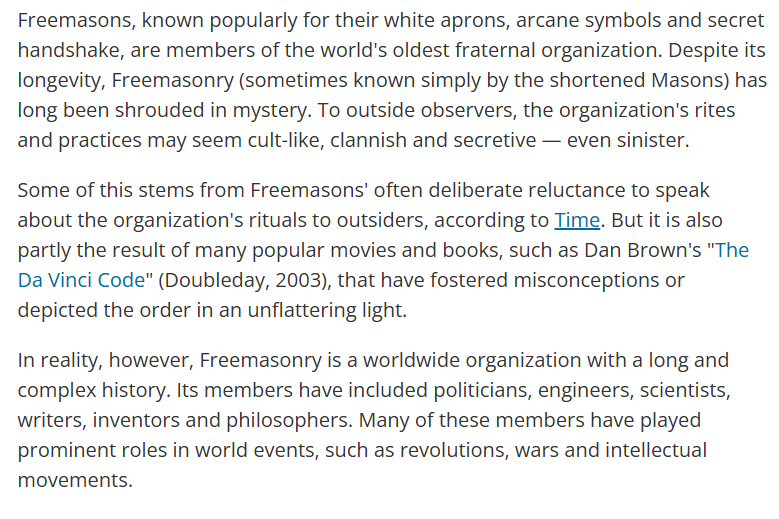
Freemasons: History, facts and myths | Live Science
This is not to say that Freemasonry is wholly secular and devoid of religious aspects. Its members are encouraged to believe in a supreme being, which in the parlance of Masonry, is known as the "Grand Architect of the Universe," Jacob added.
This Grand Architect, is comparable to a Deistic creator rather than a personal God as envisioned by Christianity, according to Jacob. The concept of Deism, which has its origins in the 17th century Enlightenment, promotes the idea that the supreme being is like the ultimate "watchmaker;" a deity that created the universe but does not play an active role in the lives of its creations.
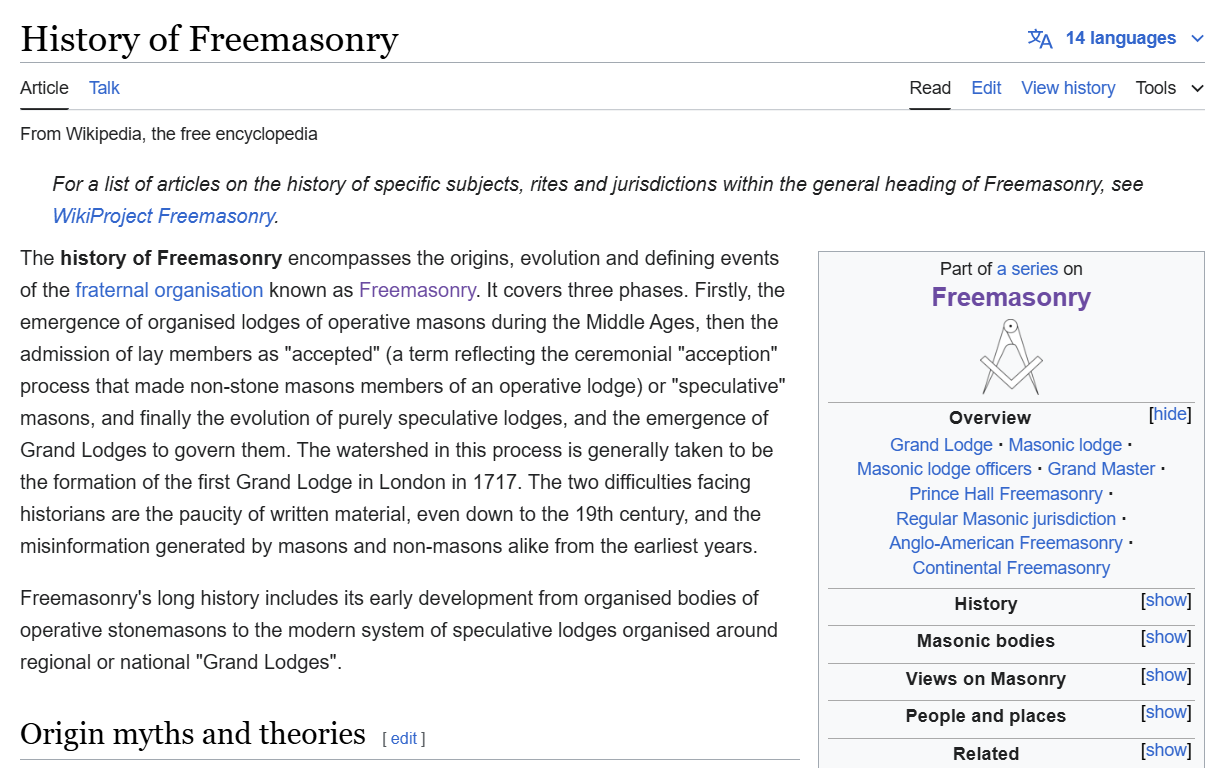
History of Freemasonry - Wikipedia
EstabliShment of Freemasonry in North America
In 1682, John Skene, Born in Scotland came to New Jersey and is dedicated by the Grand Lodge of New Jersey As the first Freemason resident in America.
Henry Price, "Provincial Grand Master of New England and Dominions and Territories thereunto belonging"
In 1733, Henry Price, the Provincial Grand Master over all of North America for the Grand Lodge of England, granted a charter to a group of Boston Freemasons. This lodge was later named St. John's Lodge and was the first duly constituted lodge in America.[79] Between 1733 and 1737 the Grand Lodge in England warranted Provincial Grand Lodges in Massachusetts, New York, Pennsylvania and South Carolina. Benjamin Franklin re-issued Anderson's 1723 constitutions as Provincial Grand Master of Pennsylvania.[4] Franklin had written in the Pennsylvania Gazette of 8 December 1730 of the several lodges of freemasons already in the "province", joined St. John's Lodge in Philadelphia the following year, and in 1732 was Junior Grand Warden of the Grand Lodge of Philadelphia. All this before the "first" lodge in North America.[80][81]
Correspondence from John Moore, the collector for the port of Philadelphia and himself a Mason, indicate that Masonic Lodges were meeting in Philadelphia in 1715. The present Grand Lodge has the Carmick manuscript, a handwritten copy of the ancient charges dating from 1727, and headed "The Constitutions of St. John's Lodge". Colonel Daniel Coxe was made Provincial Grand Master of New York, New Jersey and Pennsylvania by the Grand Lodge of England in 1730, with effect from 24 June (St. John the Baptist's day) for two years. It is unclear whether he was in America or England at the time, but he was present at Grand Lodge, at the Devil Tavern in London, on 29 January 1731, where he is minuted as Provincial Grand Master of North America. There is no record of his chartering any lodges, but he arranged for St. John's Lodge to double as a Provincial Grand Lodge, and appointed his successor in 1731, a year early. Notwithstanding the acceptance of Coxe as their first Provincial Grand Master, it has been suggested that the formation of the new Grand Lodge by consenting pre-existing lodges makes it a Grand Lodge by "Immemorial right", and a sister lodge to the Grand Lodges of England Scotland and Ireland.[82][83]
North America would have many independent lodges in the 18th century. Authorisation, which later would become a Warrant, took time and expense, especially in the period when the nearest Grand Lodge was on the other side of the Atlantic. Many lodges became "self starters", and only applied for Grand Lodge authorisation when they were reasonably confident that the lodge would survive for more than a few years. George Washington was initiated into the Lodge of Fredericksburg in 1752.[84] The same lodge was chartered by the Grand Lodge of Scotland in 1758.[27] The first properly chartered "Scottish" lodge was only two years earlier, being the Lodge of St. Andrews in Boston. Members included Paul Revere and Joseph Warren, and (according to some) later lodge outings included the Boston Tea Party.[81]
Many lodges were attached British Army regiments. The Moderns may have been wary of warranting lodges without a permanent address, so there was only one Grand Lodge of England warrant in the continental army from 1775 to 1777. The Antients and the Grand Lodge of Scotland were slightly better represented, but the overwhelming majority of regimental lodges held warrants from the Grand Lodge of Ireland.[81] Thus it was that a group of African Americans, having been rejected by the lodges in Boston, were initiated into Lodge No 441 on the register of the Grand Lodge of Ireland, which was attached to the 38th Foot (later the 1st Staffordshire). These 15 men formed African Lodge No 1, as the British departed, leaving them a permit to do almost everything but admit new masons. Two of the members were seafarers, and obtained entrance to a lodge in London, being recognised as regularly initiated Masons. This enabled their master, Prince Hall, to apply to the Moderns for a charter, which was duly granted on 29 September 1784, now as African Lodge No. 459. Such was the success of the lodge that it became a Provincial Grand Lodge, and Prince Hall the Provincial Grand Master. After his death, the provincial lodges reconstituted themselves as a grand lodge (African Grand Lodge), becoming Prince Hall Grand Lodge in 1847.[85] Around the same time, the history of Freemasonry in Mexico can be traced to at least 1806 when the first Masonic lodge was formally established in the nation.[86]
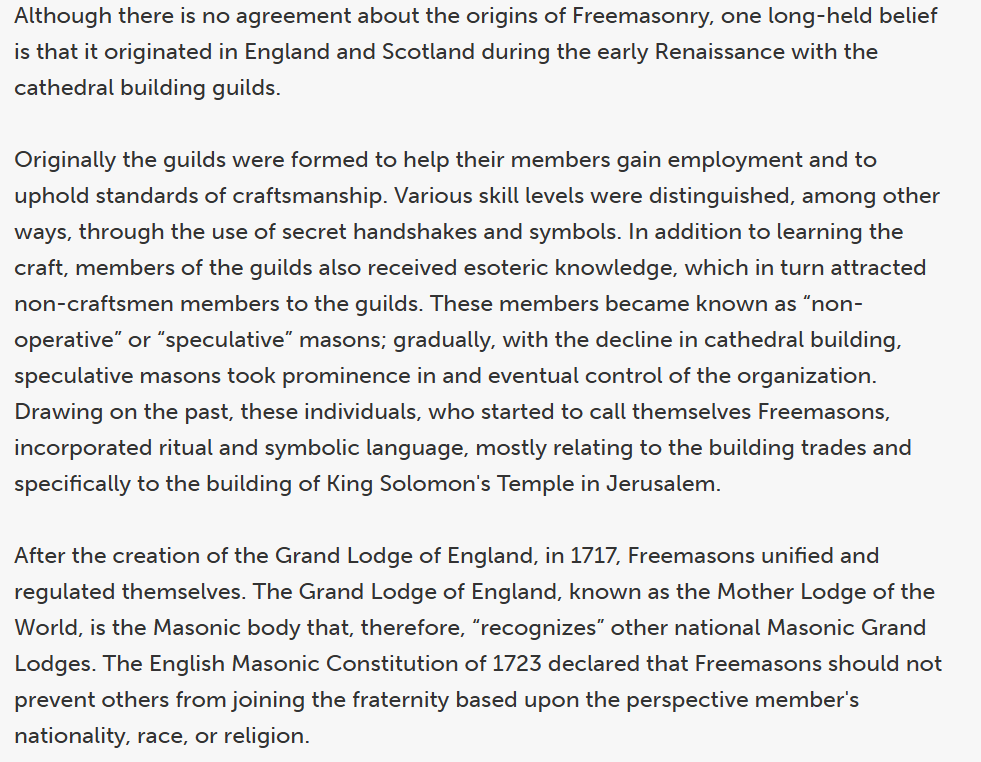
Freemasonry | Holocaust Encyclopedia (ushmm.org)
Freemasonry began admitting Jews as members in the mid-eighteenth century, first in England and then later in the Netherlands, France, Germany, and other countries. Nevertheless, European Freemasons tended to be ambivalent about who they allowed to join their organization. In some countries and in some locations, Masons allowed Jews to join their lodges. Other countries and other lodges, however, took deliberate steps to reject Jews from becoming members. The antisemitism that some Jews experienced while trying to join fraternal lodges was one reason for the creation of Jewish fraternal organizations, such as B'nai B'rith. German Jews founded the Berlin branch in 1885.
Most German Masonic lodges and their members affiliated with three Grand Lodges located in Prussia and known collectively as the “Old Prussian Grand Lodges.” These Grand Lodges and their subordinate lodges deliberately excluded non-Christians from membership. By 1922, they accounted for 70 percent of all Masons in Germany and numbered about 47,000 men. Six other Grand Lodges in Germany, including their subordinate lodges, were known as “Humanitarian” Lodges, because they accepted Jewish and Muslim males as well as Christians. Thus, a German Jew had to apply to a Humanitarian Lodge if he wanted to have any chance of joining a German Masonic lodge. In 1928, the Humanitarian Lodges had 24,000 members, and less than 3,000 of these were Jews.
Right-wing, conservative political leaders in Europe began to link Jews with Freemasons in the eighteenth century. Conservatives and Catholic clerics initially painted the Freemasons as hostile to religion and to the accepted aristocratic and clerical order. Since Masonic lodges were generally located in the larger cities of western Europe and England, where the majority of west European Jews lived, a rural distrust of an urban influence helped to cement the link between Jews and Freemasons. Conservatives and clerics throughout Europe blamed the coming of the French Revolution as well as all of its excesses, in part, on perceptions of a liberal, anti-clerical, and anti-aristocratic philosophy of the Freemasons.
During the nineteenth century, both antisemites and those opposed to Freemasonry argued that Jews manipulated Masonic ideology and international connections for nefarious purposes. They charged that Freemasons operated as front men for the Jews who preferred to remain inconspicuous and that the perceived Masonic belief in racial equality and human progress was a tool to serve Jewish interests, including the establishment of Jewish emancipation.
Among the most vociferous proponents of this thesis were conservatives in the Roman Catholic Church and members of the aristocracies in western and central Europe. French monarchists blamed the Jews and Freemasons for creating the Third Republic, where Jews enjoyed equal rights, aristocrats lost their special privileges, and the Catholic Church was, after 1905, separated from the state. Pope Leo XIII branded Freemasonry an enemy of “religion and society”: in his 1884 encyclical Humanum Genus, Leo claimed that Freemasons wanted to replace a Kingdom of God on earth by a kingdom of Satan under Freemason control. In 1894, the notorious French antisemite, Edouard Drumont, lent his support to an anti-Masonic world congress in Italy.
In Russia, the infamous racist forgery Protocols of the Learned Elders of Zion (1905) linked Jews and Masons in a conspiracy to control the world, by charging that the lodges were in the service of the “Elders of Zion.” After World War I, antisemites translated the Protocols into many languages, including English. In the United States, the influential and popular industrialist Henry Ford sponsored and supported the Protocols allegations.
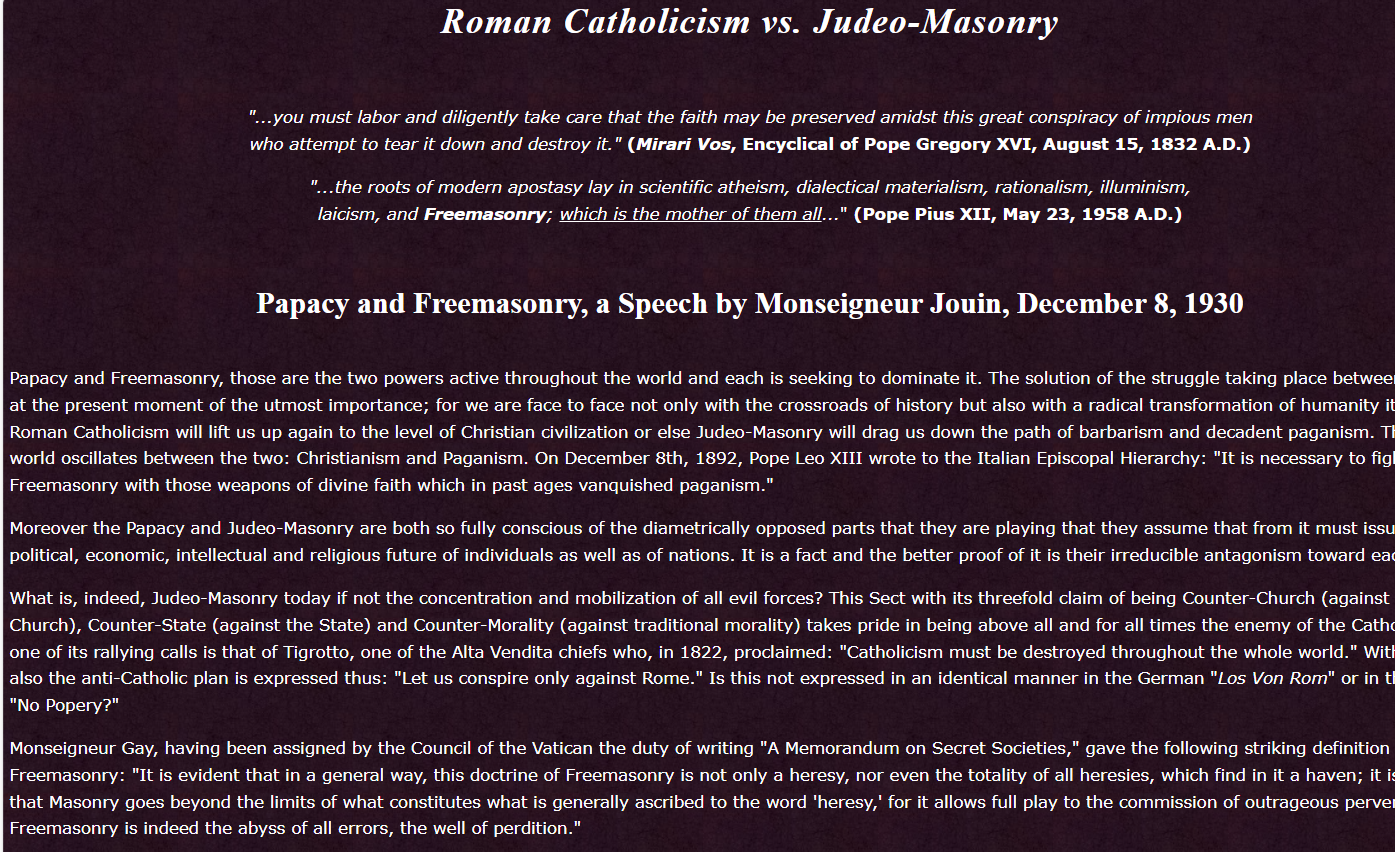
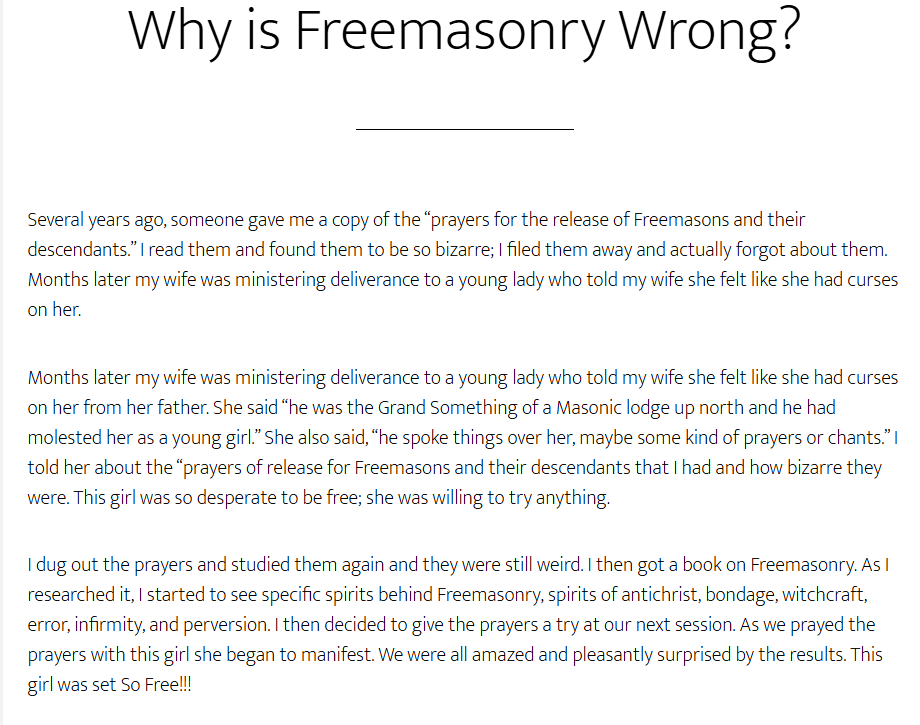
Why is Freemasonry Wrong? - RAM Ministry
Regardless of what Masons believe or say, Freemasonry is a false religion steeped in witchcraft, which mixes the Holy with the profane and invites in spirits of error and perversion among others. Once the door is opened and the enemy has been given a legal right, the attack against the children is relentless until the devil gets his due. I cannot tell you the number of horrible stories of perversion, rape, molestation, and incest we’ve heard. The next fruit of Freemasonry we see is infirmities, primarily breathing or lung disorders, with asthma and allergies leading the list. We also see a host of other ailments we can directly attribute to the curses of Freemasonry. Two emotional areas we see heavily affected by Freemasonry are anger and fear. As we look into the rites and rituals of freemasonry the reasons for the fruits of Freemasonry become quite evident.
Rites and rituals of Freemasonry
The deceptive nature of Freemasonry begins with induction and membership in the lodge. When a member of the lodge wants to get someone to join the lodge, he is not allowed to ask that person to join. Instead he has his wife ask that person’s wife to have him to ask the member about the lodge. This is deliberate in order to give the devil a legal right to torment that person and his family. He opened the door himself by asking about membership in the lodge. When they join the lodge they go through an initiation ceremony.
In that ceremony the initiate is bare-chested and blindfolded with a noose around his neck. He is then taken outside the lodge, they knock on the door and a person inside asks the initiate what he wants? He then answers by saying, “I want to come out of the darkness and enter into the light of freemasonry.” The initiate is then brought into the lodge still blindfolded and a dagger or sword or other sharp object is placed against his bare chest. He then swears the first of many blood oaths and curses over himself and his family. He agrees to be murdered or mutilated if the oath of the degree is violated.
The spirit of infirmity comes in from the noose around the neck, which is evidenced by the fruit of asthma, allergies and other breathing disorders in the descendants of Freemasons.
It is the belief of Freemasons that each degree obtained, brings them closer to the light, and to enlightenment. However deception is a key ingredient in Freemasonry, the initiate never really knows the truth. Albert Pike, considered to be the father of modern freemasonry; in his book “Morals and Dogma of Freemasonry” Wrote this:
“Masonry like all religions, all the mysteries conceals its secrets from all except the Adepts and Sages, or the Elect and use false explanations and misrepresentations of its symbols to mislead those who only deserve to be misled…
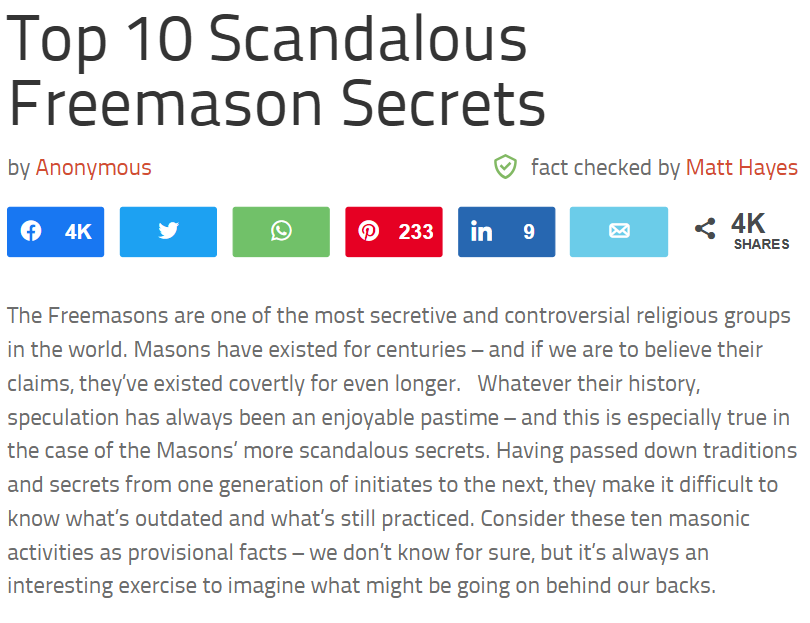
Top 10 Scandalous Freemason Secrets - Listverse
The Freemasons are one of the most secretive and controversial religious groups in the world. Masons have existed for centuries – and if we are to believe their claims, they’ve existed covertly for even longer. Whatever their history, speculation has always been an enjoyable pastime – and this is especially true in the case of the Masons’ more scandalous secrets. Having passed down traditions and secrets from one generation of initiates to the next, they make it difficult to know what’s outdated and what’s still practiced. Consider these ten masonic activities as provisional facts – we don’t know for sure, but it’s always an interesting exercise to imagine what might be going on behind our backs.
Freemason Ranks And Degrees: A Look Into The Big Boys Club (gsminsider.com)
Did you know that the Freemasons are the largest secret society in the world? While the Freemasons have often been mistaken for a Christian organization, they have often encountered strong opposition from the Roman Catholic Church for flouting their conventions.
Freemasons have been at the core of numerous conspiracy theories. There are several allegations that they are a cult and that they control the world from the shadows. Seeing as they’re an incredibly private group and also sworn to secrecy, the full range of their operations isn’t known.
In most countries, Freemasons are split into 3 major degrees – entered apprentice, a fellow of the craft, and master mason. However, in the Scottish rite, there are 30 more degrees to becoming a Mason. Here’s all you need to know about Freemasonry ranks.
Who are the Freemasons?
Freemasons are not governed by the authority of any religion. They are however concerned strongly with the spiritual domain of an individual’s life and accept people of all faiths and beliefs on equal terms. Having faith in the existence of a supernatural being and the immortal soul are the other prerequisites for joining, besides being a man.
Freemasons consider themselves as the architects of the world created by an elusive supreme being. They believe in enhancing their own views of the world by engaging in open dialogues and discussions with people holding different worldviews. The philosophy of Freemasonry connects morality, charity, and civil obedience to the law of the land.
To put it simply, freemasonry accepts good men with hopes of turning them into better men, better husbands, fathers, brothers, citizens, etc. but through a combination of guided and self-guided processes that vary from rite to rite.
Freemasonry consists of multiple fraternal organizations now present throughout the world as the result of the British conquest. It is a male-only fraternity that traces its origins back to the local fraternities and stonemasons in the late 14th century.
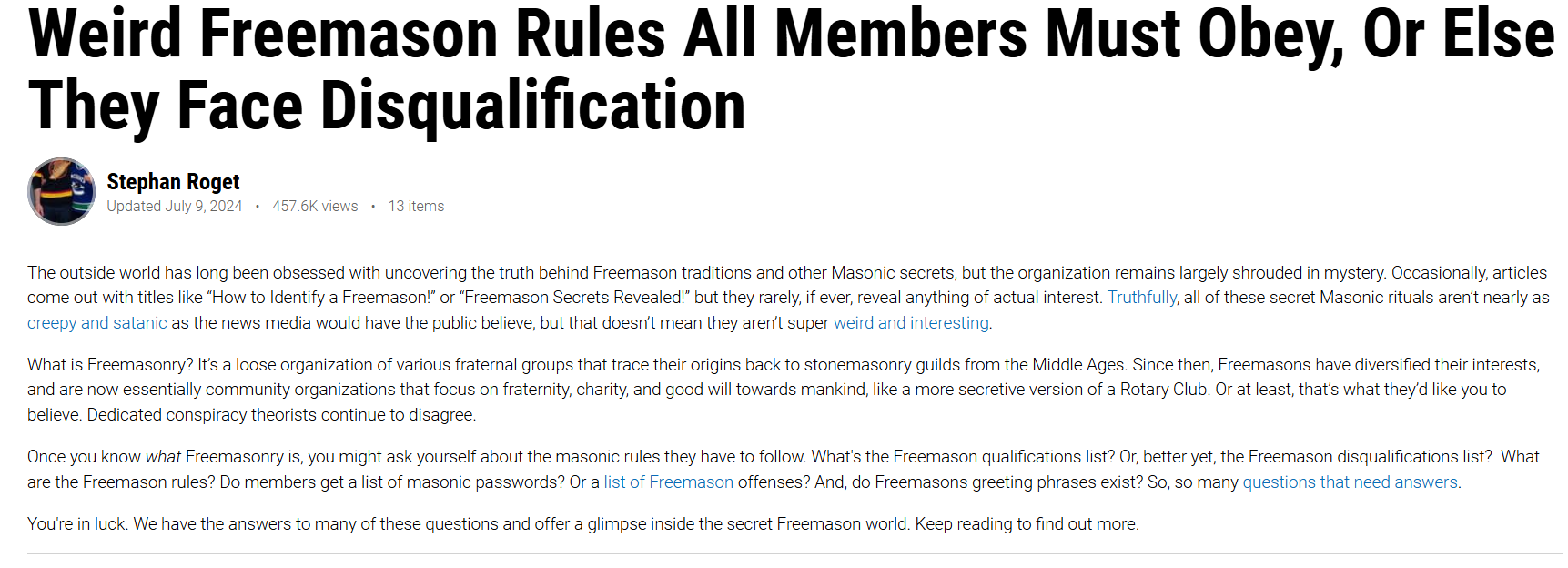
Weird Rules All Freemasons Must Obey, Or Else They Face The Consequences (ranker.com)
- The Basic Qualifications Rule Out A Lot Of People
- The basic qualifications that one must have in order to join a Freemason Lodge at the entry level seem simple, but are actually quite exclusionary. For one, with the exception of a few unofficial chapters, only men are welcome to become Freemasons. Anyone wishing to join must be sponsored by two established Freemasons, although inheritance is possible.
- Finally, everyone wanting to join must attest that they believe in one singular Supreme Power - a monotheistic god, but not necessarily the Christian one. In other words, only men who believe in God can join, and even then they need connections.
- Freemasons Can’t Talk About Religion Or Politics At Meetings
- Despite the qualifying question for Masonic membership, discussion of personal religion is actually forbidden within Freemason Lodges. The organization is usually described as “religious, but not a religion,” and they don’t endorse any one monotheistic religion over another. Religion isn’t the only forbidden topic in a lodge, as discussion of politics is also banned.
- Lodges are often accused of being the location of secretive political deal-making, but the most basic rules of Freemasonry outlaw any such conversation. That’s not to say that political discussions aren’t held between various Masons outside of their official meeting places.oo: Wikimedia Commons
- You Can’t Bring Your Outside Status Inside The Lodge
- The fraternity of the Freemasons is based on equality and equity within the organization. A wide variety of people have joined the order, including a great number of presidents and other important and influential individuals. However, all such grandiose titles must be dropped at the door when entering a Masonic Lodge.
- Real world status means nothing to Freemasons when meetings are held, and the only status that matters is one’s level of achievement within Freemasonry. Everyday laborers stand shoulder-to-shoulder with titans of industry inside a Masonic Lodge.
- Secret Handshakes, Knocks, And Passwords Are Lodge-Specific
- It has long been rumored that all Freemasons learn a secret handshake, but that doesn’t appear to be true. Although each lodge is sure to have its own rituals, and handshakes, passwords, and secret knocks are part of that, these would be specific to each individual order.
- Although Freemasonry exists worldwide, most individual orders are only loosely affiliated with one another, meaning there’s no such thing as a universal Freemason handshake. However, some members will attest that, “you can still find out a mason by the way he shakes your hand, if you're aware.”
- Getting In Involves “Death” And Resurrection, But That’s Just The First Step
- One of the main reasons why Freemasonry is so associated with satanic ritual and other dark beliefs is the admittedly macabre initiation ritual that one must go through in order to be inducted. Although the exact ritual differs from chapter-to-chapter, the commonality is usually a mock death in which the individual is blindfolded with a rope around their neck, and then has a knife brandished at their bare chest.
- After this symbolic death, the individual is “resurrected” as a Freemason. Most members describe it as a theatrical performance. However, this is only the beginning. Freemasons must advance the ranks of Freemasonry by earning “degrees,” of which there are an astonishing 33!
- Once You Advance Enough, You Get To Learn God’s Secret Name!
- Eventually, a Freemason can receive enough degrees to become a Master Mason, after which they’re invited to join the Supreme Order of the Holy Royal Arch. Reportedly, this is when members become privy to the ultimate secret of the Freemasons—the true name of the Great Architect of the Universe. In other words, God’s real name.
- Of course, this supposed secret has long since leaked, and God’s real name is Jahbulon. So, if anyone wanted to join the Freemasons just to find out God’s real name, it’s Jahbulon, and you can save yourself the time and effort.
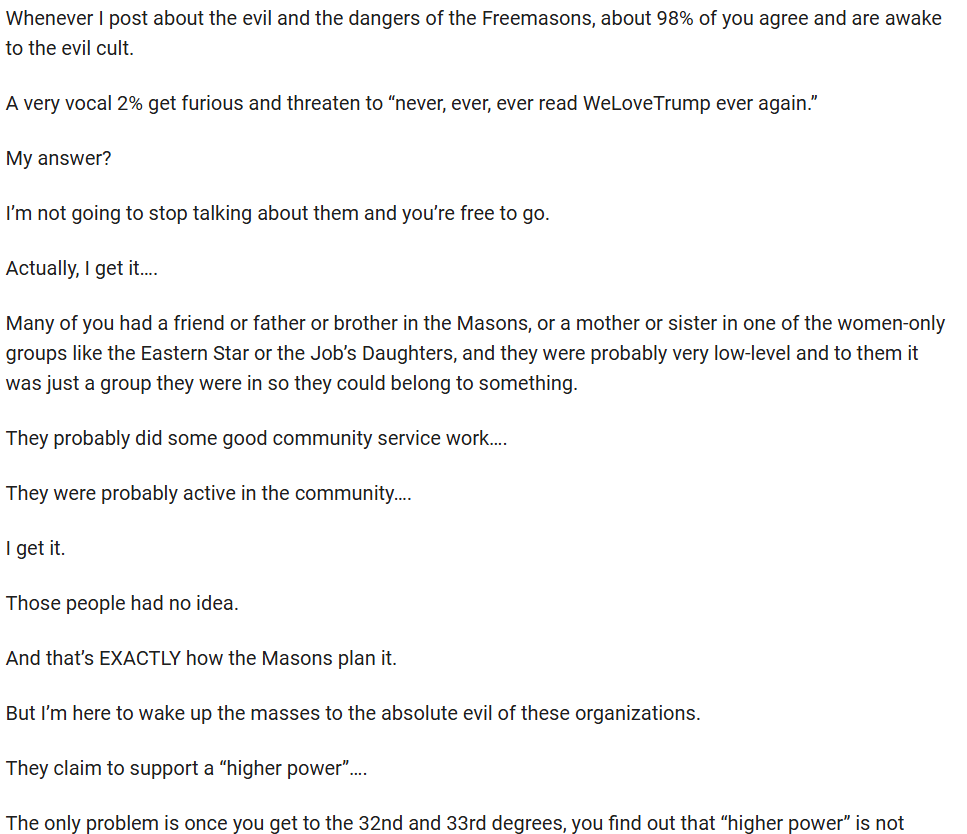
Ex-Freemason Exposes Satanic Secrets Of International Cult (welovetrump.com)
"...you must labor and diligently take care that the faith may be preserved amidst this great conspiracy of impious men
who attempt to tear it down and destroy it." (Mirari Vos, Encyclical of Pope Gregory XVI, August 15, 1832 A.D.)
"...the rootsThe Catholic Church takes the structure of Freemasonry very seriously, forbidding membership by any Catholic. The Vatican issued its first papal condemnation in 1738, decreeing excommunication for any Catholic Freemason. Many Catholics were originally Masons, including Vatican prelates, and church officials often turned a blind eye, especially in England. The Greek Orthodox Church condemned Masonry in 1933 as a heathen mystery religion. Stephen Knight, author of Operative Masonry, claimed that during the ritual for the Holy Royal Arch candidates learn the secret name of God—Jahbulon: Jah for Yahweh, Bul for the Canaanite fertility god Baal, and On for Osiris. Such references, he contended, proved devil worship.
Freemasonry, as well as Rosicrucianism, received a boost in popularity with the 2003 international bestselling novel The Da Vinci Code. Author Dan Brown ties Rosicrucianism and Freemasonry to the legends of the so-called Priory of Sion, a secret order descended from the lost Knights Templar, to prove that Mary Magdalene is the real holy grail.
But when it comes to researching freemasonry or even being able to speak to members of this hand-picked private religion, such will tell you that they are not a “secret society” and are now “very open and transparent.” That, of course, is far from the truth and not even remotely honest, for they will not allow cameras inside their lodges to film their religious services, nor will they allow their macabre rituals to be aired online or on air for all to see.
In fact, their religion is so secretive and selective, that Freemasons are unable and unwilling to share their religion in public, distribute pamphlets or DVDs to passersby, or warn people that the penalty of being a non-Mason will result in spending eternity in Masonic hell! The point being, they have no good news for non-freemasons and no warning or penalty for non-freemasons. It’s simply a Babylonian humanistic deistic religious set-up!
For those that know next to nothing about the Freemasons, the Catholic church, the Orange Order, and their associates, I believe this article will expose Freemasonry for what it really is – evil from top to bottom – and may God Almighty use this article to help free those trapped in its clutches.
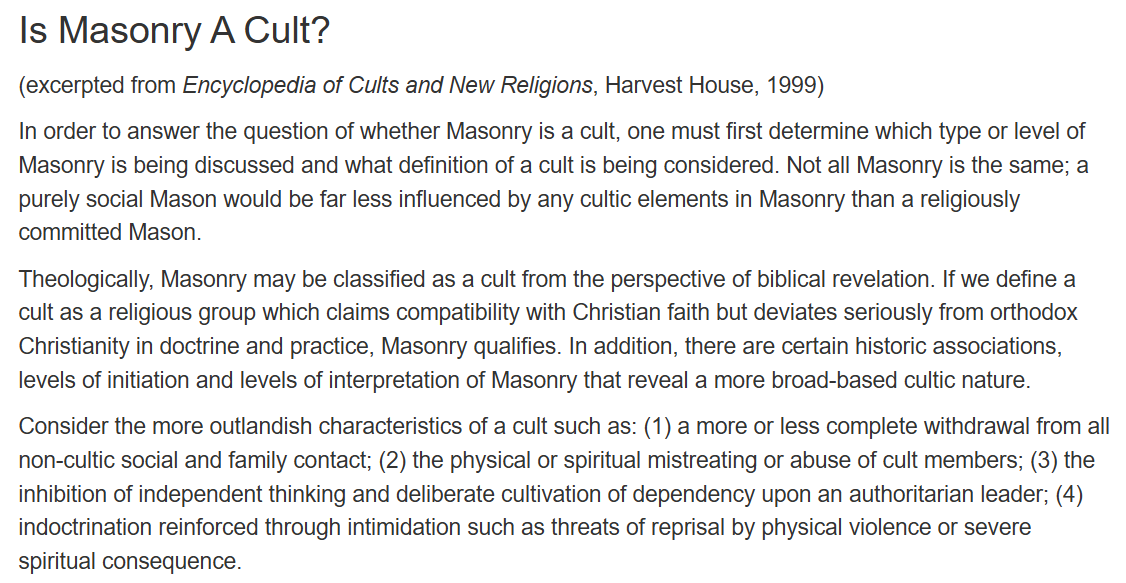
Is Freemasonry A Cult? - JA Show Articles
In order to answer the question of whether Masonry is a cult, one must first determine which type or level of Masonry is being discussed and what definition of a cult is being considered. Not all Masonry is the same; a purely social Mason would be far less influenced by any cultic elements in Masonry than a religiously committed Mason.
Theologically, Masonry may be classified as a cult from the perspective of biblical revelation. If we define a cult as a religious group which claims compatibility with Christian faith but deviates seriously from orthodox Christianity in doctrine and practice, Masonry qualifies. In addition, there are certain historic associations, levels of initiation and levels of interpretation of Masonry that reveal a more broad-based cultic nature.
Consider the more outlandish characteristics of a cult such as: (1) a more or less complete withdrawal from all non-cultic social and family contact; (2) the physical or spiritual mistreating or abuse of cult members; (3) the inhibition of independent thinking and deliberate cultivation of dependency upon an authoritarian leader; (4) indoctrination reinforced through intimidation such as threats of reprisal by physical violence or severe spiritual consequence.
Masonry contains elements of some of these characteristics. It keeps Masonic secrets from family members, its oaths can be spiritually abusive, manipulative and intimidating, and they imply retribution for their violation. The ritual may in certain ways function to suppress independent thinking and dependency on Masonry. Masons must obey Lodge authority and Masonry itself.
Here are eight characteristics of cults that are to varying degrees shared with Masonry.[1]
1. Masonry has parallels to ancient pagan cultic themes and beliefs. This has been documented in chapters 17-19 of The Secret Teachings of the Masonic Lodge,[2] dealing with the occult generally (chapter 17), spiritism specifically (chapter 18) and the Ancient Mystery Religions (chapter 19). Many other researchers have noted the correlations. Martin L. Wagner spent years of diligent study of Masonry.[3] He was the pastor of Saint John’s English Evangelical Lutheran Church in Dayton, Ohio, and he concluded that the peculiar views of Masonry harmonize it “with the religions of the ancient cults.”[4] “The Masonic ritual has many elements which have come down from antiquity, and connect the modern institution with the cults of the ancients not so much in form as in doctrine.”[5] In speaking of the unity of Freemasonry with such pagan cults, he emphasizes that this is not to be seen in the externals of the Craft, “not in exact identity of ceremony and symbol, but in the religious ideas, in the object of its adoration, in its conception and definition of the deity.”[6]

What is Freemasonry – Grand Lodge Ancient Universal Mysteries (grandlodgeaum.org)
In the Mystery Schools of past ages, such as those in India, the Zoroastrians, Mithraic, Chaldæa, Egypt and Greece, one of the significant methods of training and teaching (as well as by other methods) was by dramatic representations and enactments of those observances (the Ancient Mysteries) which taught the origin of things, the nature of the human spirit, its relations to the body, and the methods of its purification and restoration to a higher life expression. Though the forms through which this body of teaching pertaining to man’s essential divinity has adapted to culture and time, nothing of its essential value has been lost and is thus preserved for us today in modern Freemasonry for those who can see it. In fact, all systems of the Mystery teachings of past ages today terminate in modern Masonry, and hence, the modern Mason is the heir of the ages. It is perhaps this type of unconscious recognition that causes Freemasonry to stand before the judgment seat of humanity’s expectations at this time, for it is perhaps unconsciously sensed that Freemasonry has yet to live up to its divine expectations and purpose in its service to humanity as a whole. Nevertheless, the new and coming Aquarian Age will see Masonry come into its own and fulfill its greater purposes and responsibilities in the coming age that is to be governed by the two primary rays of Freemasonry, Rays Four and Seven.
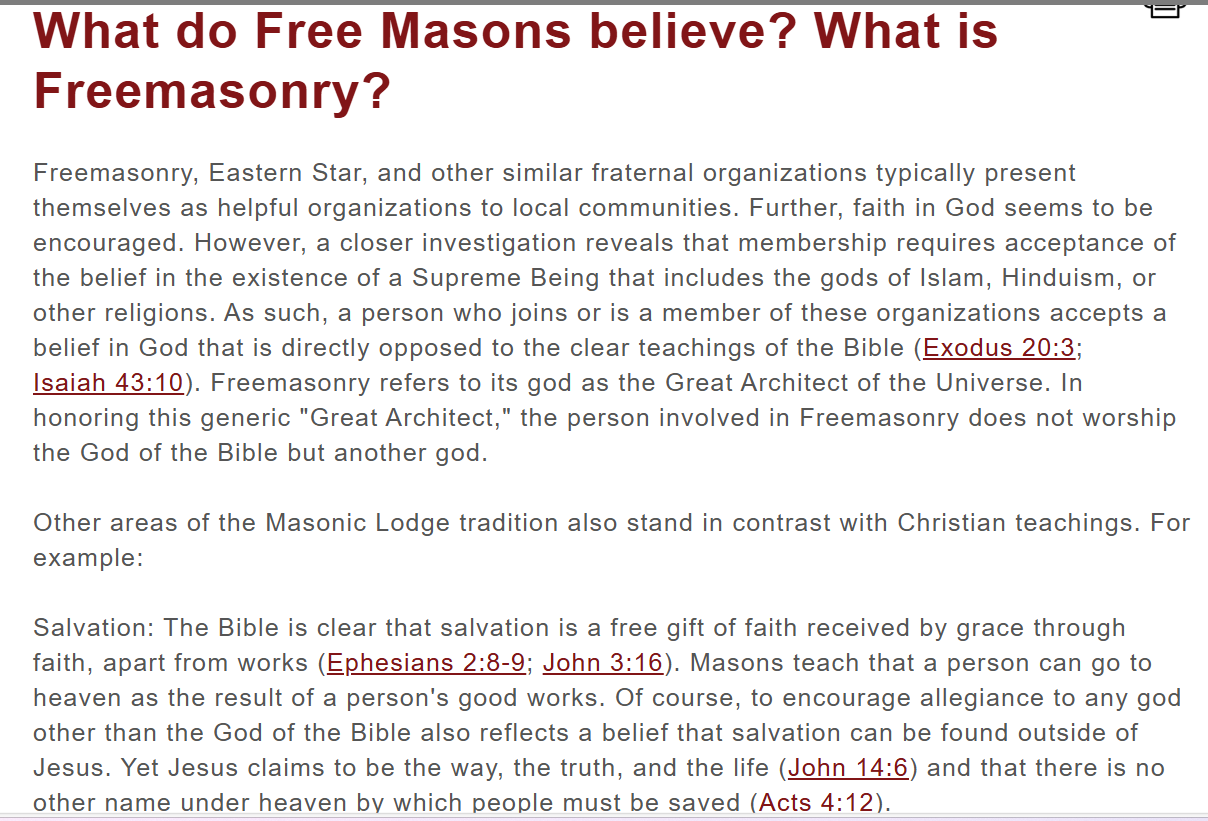
What do Free Masons believe? What is Freemasonry? (compellingtruth.org)
Freemasonry, Eastern Star, and other similar fraternal organizations typically present themselves as helpful organizations to local communities. Further, faith in God seems to be encouraged. However, a closer investigation reveals that membership requires acceptance of the belief in the existence of a Supreme Being that includes the gods of Islam, Hinduism, or other religions. As such, a person who joins or is a member of these organizations accepts a belief in God that is directly opposed to the clear teachings of the Bible (Exodus 20:3; Isaiah 43:10). Freemasonry refers to its god as the Great Architect of the Universe. In honoring this generic "Great Architect," the person involved in Freemasonry does not worship the God of the Bible but another god.
Other areas of the Masonic Lodge tradition also stand in contrast with Christian teachings.
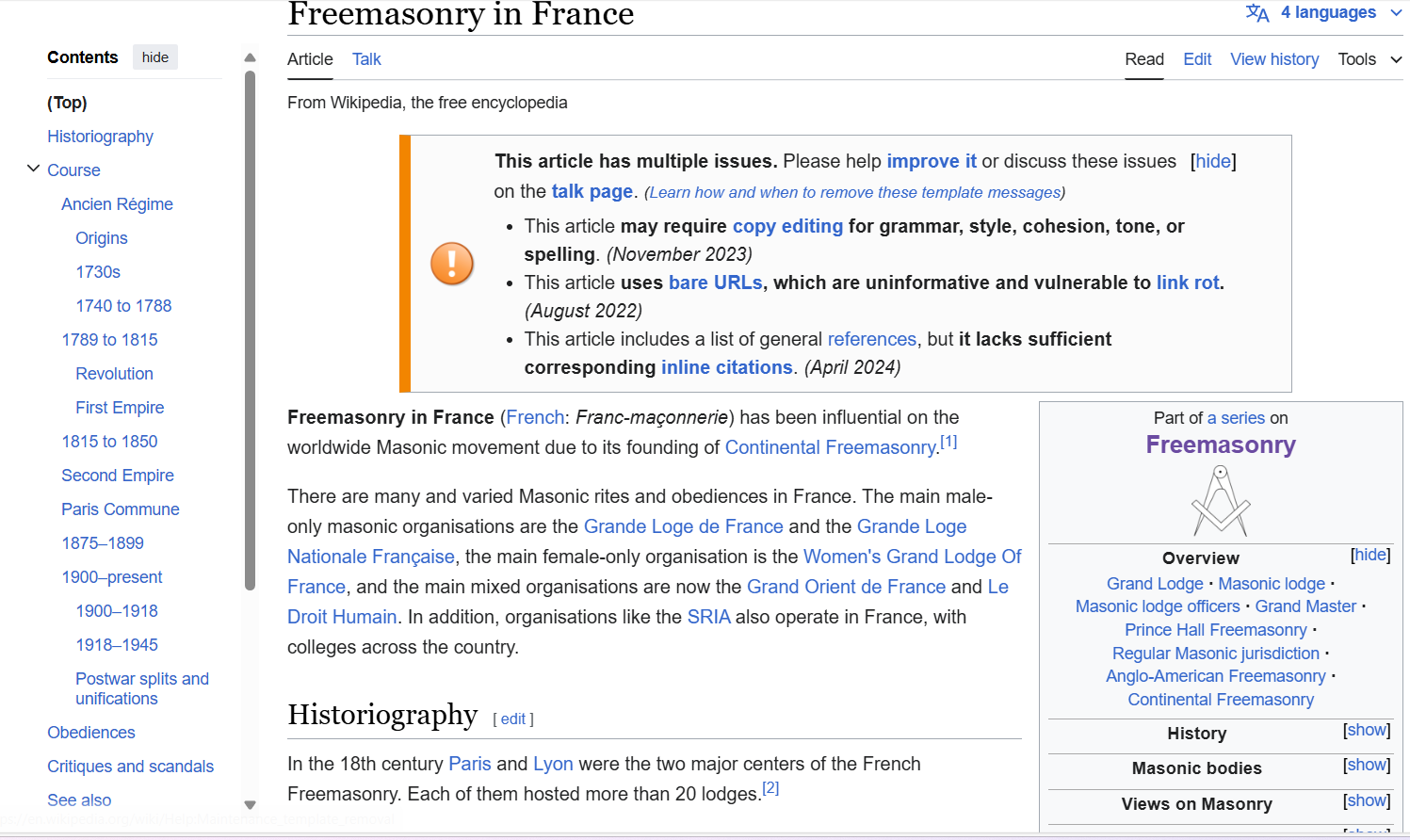
Freemasonry in France - Wikipedia
After the French Revolution, the Jesuit Augustin Barruel wrote that Freemasons had actively prepared the 1789 revolution, which has been used to back theories of a Masonic plot. This thesis was often reprised later, notably during the French Third Republic, by Catholic authors (using it to oppose both the Republic and Freemasonry) and by Freemasons (so as to reinforce their pro-Republican stance and their positive image with the Republican government). In reality, there were Freemasons in both the Republican and monarchical camps. The Duke of Luxembourg, right-hand man to the Grand Master and moving-force behind the creation of the Grand Orient de France, emigrated in July 1789 and an aristocratic lodge known as "La Concorde" fled from Dijon as early as August 1789.[15] Having become "Philippe-Égalité", the Grand Master of the Grand Orient himself publicly renounced Freemasonry[citation needed] in 1793 shortly before being executed by guillotine.
Even though the Grand Orient proclaimed its attachment to the democratic form of government from January 1789 onwards, it was forced to cease its activities by the Terror between 1793 and 1796, and of the nearly 1000 lodges active on the eve of the Revolution only 75 were in a fit state to resume their activities in 1800.[16] Nevertheless, by their functioning in the years before the Revolution, these lodges had assumed a certain independence from the State and the Church, probably giving rise to new aspirations. Among active Freemasons in the Revolutionary period were Mirabeau, Choderlos de Laclos and Rouget de l'Isle, writer of the national anthem "La Marseillaise". In the French Egyptomania which followed their invasion of Egypt in 1799, around 1810 the Rite of Misraïm and "Egyptian" Freemasonry appeared among French troops based in Italy, later spreading to France in 1814.
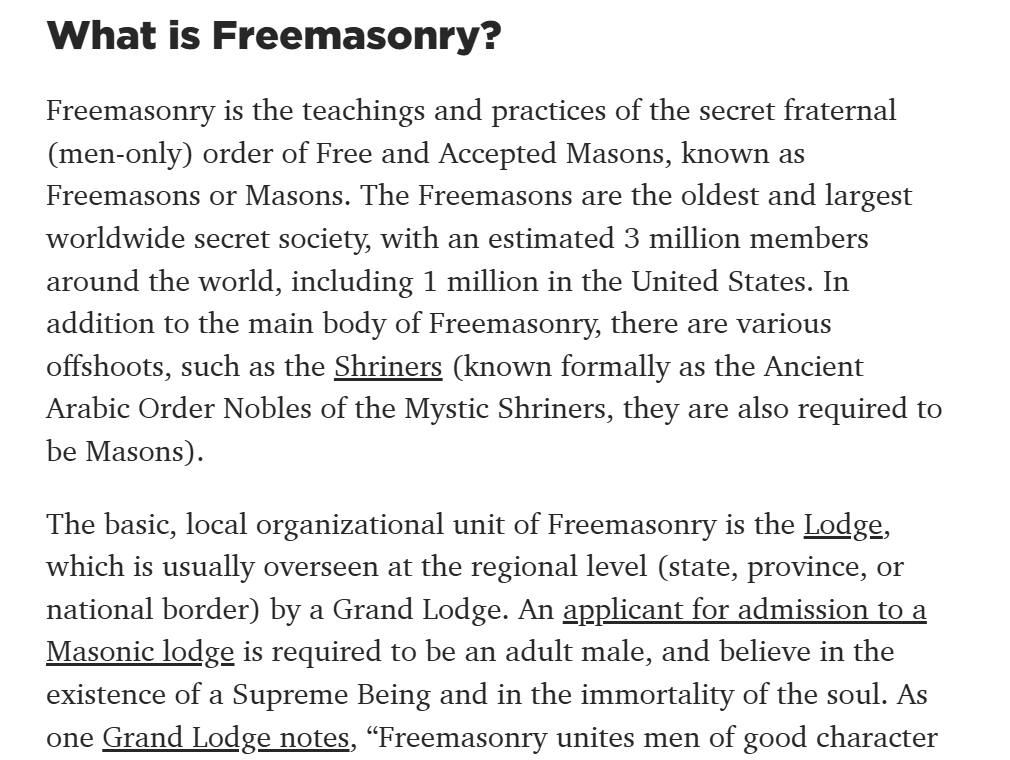
The FAQs: Is Freemasonry Compatible with Christianity? (thegospelcoalition.org)
Some of the stated reasons for claiming Freemasonry is incompatible with Christianity include:
Freemasonry is a religion.
“On this score the evidence is overwhelming. There is no room for any reasonable doubt as to Masonry’s being a religion. Not only do the symbols, rites and temples of this order point unmistakably to it as a religion, but a great many Masonic authors of note emphatically declare it to be just that. Of almost numberless quotations that could be given here the committee has selected a few.
S. M. Ward, the author of several standard Masonic works, defines religion as ‘a system of teaching moral truth associated with a belief in God” and then declares: “I consider Freemasonry is a sufficiently organized school of mysticism to be entitled to be called a religion.’ He goes on to say: “I boldly aver that Freemasonry is a religion, yet in no way conflicts with any other religion, unless that religion holds that no one outside its portals can be saved” (Freemasonry: Its Aims and Ideals, pp. 182, 185, 187).” – Orthodox Presbyterian Church
Freemasonry involves and promotes idolatry.
“Masonry is guilty of idolatry. Its worship and prayers are idol worship. The Masons may not with their hands have made an idol out of gold, silver, wood or stone, but they created one with their own mind and reason out of purely human thoughts and ideas. The latter is an idol no less than the former.” – Wisconsin Evangelical Lutheran Synod
“It is because tenets and practices of Freemasonry conflict with the biblical Gospel of Jesus Christ that our church from its very beginning has held that membership in this organization conflicts with a faithful confession of this Gospel.” – Lutheran Church Missouri Synod
Freemasonry promotes universalism.
“The heresy of universalism (the belief all people will eventually be saved) which permeates the writings of many Masonic authors, which is a doctrine inconsistent with New Testament teaching.” – Southern Baptist Convention
Freemasonry promotes a works-based view of salvation.
“Confidence in these secret orders and their teachings has always tended toward the embracing of a false hope of salvation through good works and improved moral service (Eph. 2:8–9).” – Assemblies of God
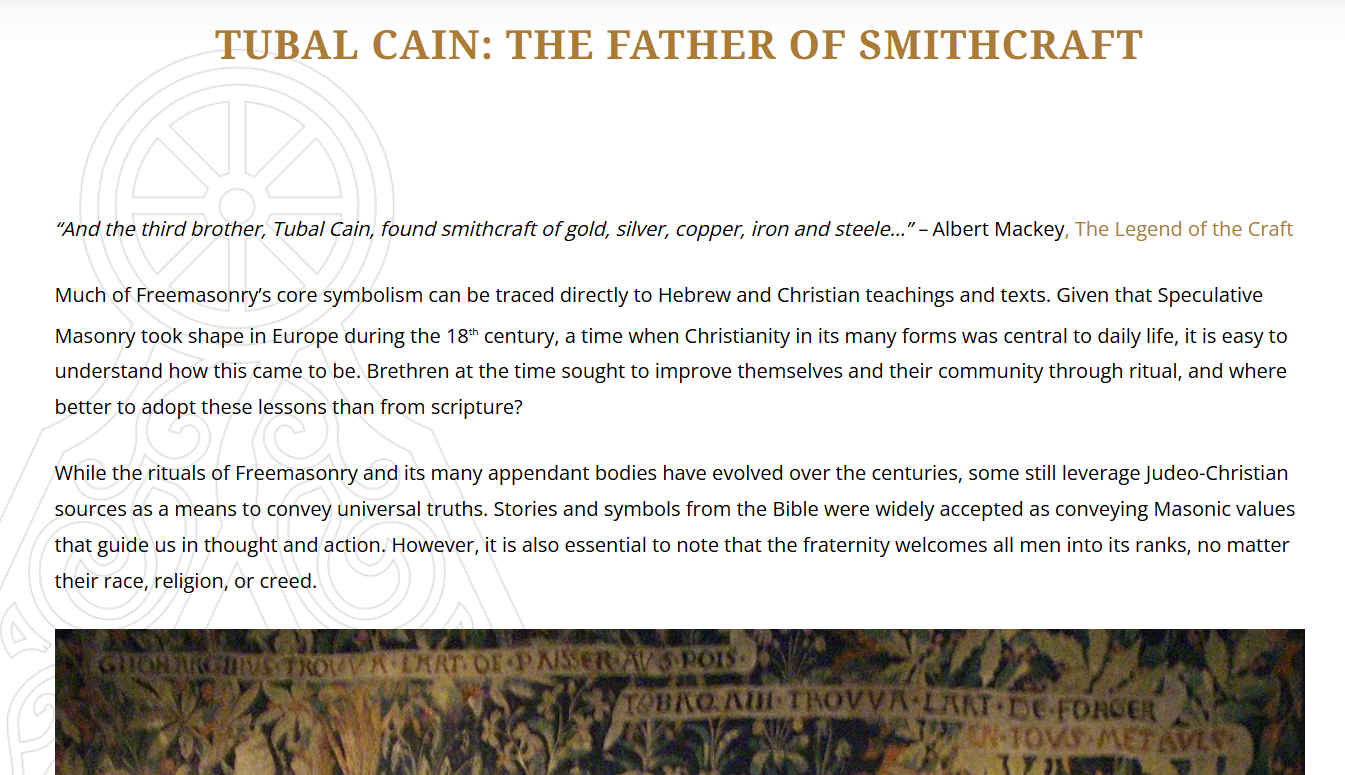
Tubal Cain The Father of Smithcraft | Freemasonry
TUBAL CAIN
Among the figures adopted from the Bible for Freemasonry is Tubal Cain from Genesis 4:22. Known as the first blacksmith, Tubal Cain is a descendant of Adam and Eve and the son of Lamech and Zillah. While it is not known when Tubal Cain emerged in the ritual of Speculative Masonry, the famous Masonic author and historian Albert Mackey referred to him in his book A Lexicon of Freemasonry as the “first to work in iron and brass.” In this passage, Mackey wrote that Tubal Cain:
…introduced many arts into society which tended towards its improvement and civilization. Tubal Cain is the Vulcan of the Pagans, and is thought to have been closely connected with ancient Freemasonry. Faber says that “all the most remarkable ancient buildings of Greece, Egypt, and Asia Minor, were ascribed to Cabirean or Cyclopean Masons,” the descendants of Vulcan, Dhu Balcan, the god Balcan, or Tubal Cain. Oliver says, “In after times Tubal Cain, under the name of Vulcan and his Cyclops, figured as workers in metals and inventors of the mysteries; and hence it is probable that he was the hierophant of a similar institution in his day, copied from the previous system of Seth, and applied to the improvement of schemes more adapted to the physical pursuits of the race to which he belonged.”
Because of Tubal Cain’s significant contributions to the science of craftwork, Mackey believes he can be looked upon as our Masonic ancestor.
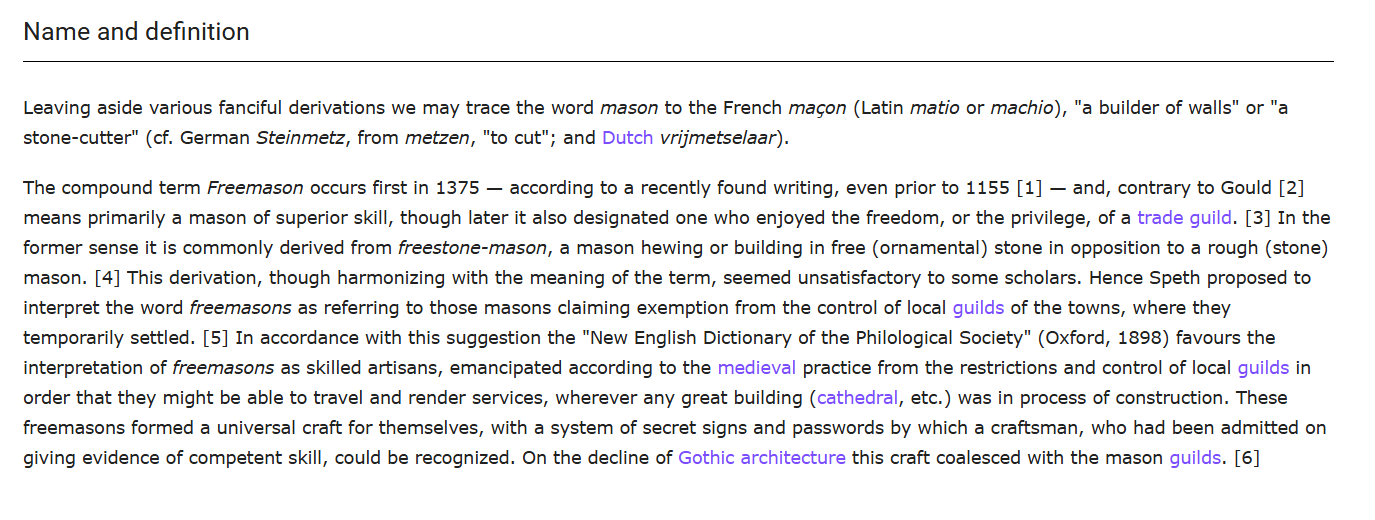
CATHOLIC ENCYCLOPEDIA: Masonry (Freemasonry) (newadvent.org)
"From first to last", says Pike [100] "Masonry is work". The Masonic "work", properly so called, is the inner secret ritualistic work by which Masons are made and educated for the outer work, consisting in action for the welfare of mankind according to Masonic principles. Masons are made by the three ceremonies of initiation (first degree), passing (second degree), and raising (third degree). The symbols displayed in these ceremonies and explained according to the Masonic principles and to the verbal hints given in the rituals and lectures of the third degrees, are the manual of Masonic instruction. The education thus begun is completed by the whole lodge life, in which every Mason is advised to take an active part, attending the lodge meetings regularly, profiting, according to his ability, by the means which Masonry affords him, to perfect himself in conformity with Masonic ideals, and contributing to the discussions of Masonic themes and to a good lodge government, which is represented as a model of the government of society at large. The lodge is to be a type of the world [101] and Masons are intended to take part in the regeneration of the human race. [102] "The symbolism of Freemasonry", says Pike in a letter to Gould, 2 December, 1888 [103] "is the very soul of Masonry." And Boyd, the Grand Orator of Missouri, confirms: "It is from the beginning to the end symbol, symbol, symbol". [104]
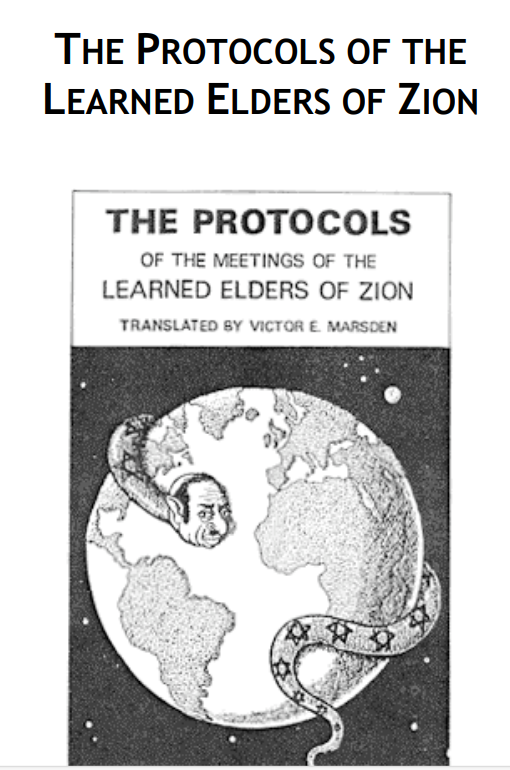
PROTOCOLS OF THE LEARNED ELDERS OF ZION - TEXT
Microsoft Word - Protocols.doc (4pcdn.org)
disclaimer: this work is often claimed to be a hoax perpetrated by nazis; if so, then it sure is a good fake
and whoever wrote it sure was prescient, you have got to admit
it reads like the communist master plan
originators of bolshevik communism were, disproportionately, composed of talmudists and kaballists, and self-professed atheists
today this book reads like a fairly accurate history of what has transpired between then and now
it is here brought to your attention as a matter of historical curiosity
and as a matter of freedom of academic inquiry
the reader should judge and decide for himself, or herself, whether it lacks historical merit, or not